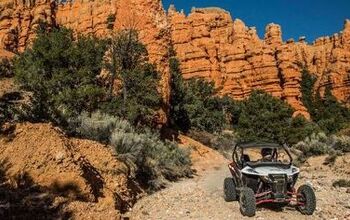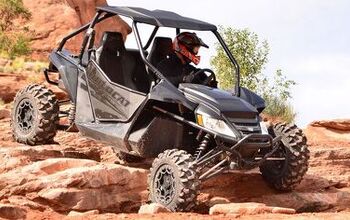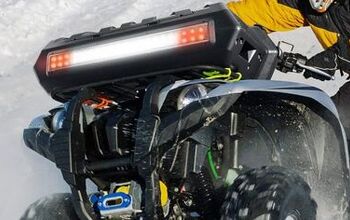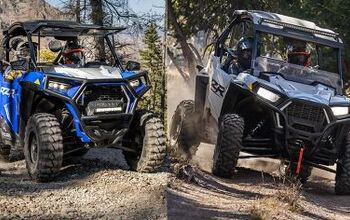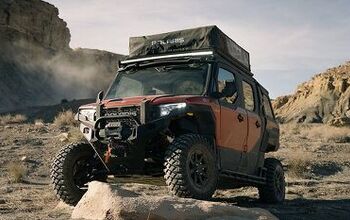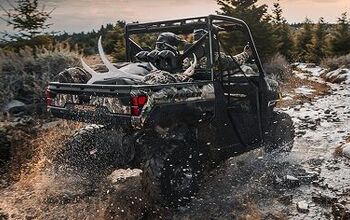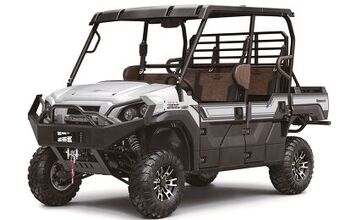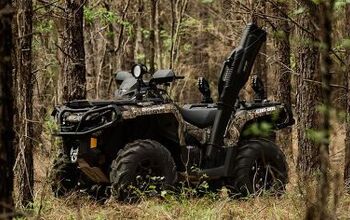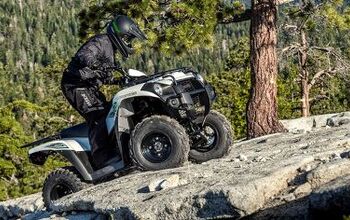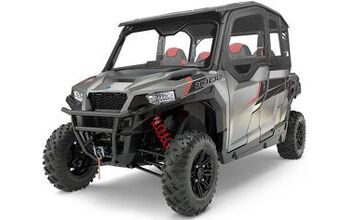2014 Arctic Cat Wildcat Trail Review
For too long the 50-inch Sport UTV segment has been ruled by one machine. Arctic Cat has changed that with the introduction of its newest models – the Wildcat Trail and Trail XT.
While the Sport UTV segment has focused on ultra powerful, long suspension desert machines in recent years, Arctic Cat has turned some much needed attention on designing a nimble woods machine. We had a chance to get behind the wheel of the Polaris RZR 800 challenger in the wilds of Gateway Canyons, Colo.
The new Arctic Cat-designed 700cc engine (built by Kymco) is an electronically fuel injected four-valve, dual overhead cam, parallel Twin that produces a claimed 60 horsepower.
Arctic Cat’s Wildcat Trail is the first challenger to Polaris’ 50-inch RZR.
This engine is coupled to an all-inclusive transmission that is tucked together tightly with an estimated overall length of about two feet. This is my humble guess and not a written fact, but it does look compact for sure. The transmission is belt driven with what Arctic Cat calls its Rapid Response Clutch system. At a glance the CVT system looks just like many on the market yet the experts at Team Industries tuned this RRC system specifically for the Wildcat Trail machine. Unique to this system is that the rear drive axles come right out of the sides of the transmission, eliminating the need for a rear differential. Essentially, the transmission becomes the rear diff. This not only allows the Wildcat Trail to be weight biased just like its big brother with a 40-60 split, but it seems to keep everything narrower as well.
Built by Kymco to Arctic Cat specifications, the compact engine produces a claimed 60 horsepower.
Stepping out to the suspension on the new kitty we find a little more travel than the typical 50-inch sport trail UTV. The front legs on the Arctic Cat Wildcat Trail swing up to 10 inches while the rear suspension will travel 10.5 inches. This gives just a bit more movement than the competition. The dual A-arm design is coupled to a front and rear sway bar that keeps the chassis just a bit tighter while riding off-camber terrain as well as offering stability while cornering. Suspension is dampened by FOX shocks. These FOX single spring, nitrogen charged, preload adjustable shocks offer suitable trail dampening for this compact ride.
COMPARISON: Polaris RZR 800 Review
Single spring Fox shocks control 10 inches of travel up front and 10.5 in the rear.
Like the full-size Wildcat, rider and passenger sit down low in the cabin. Custom sewn seats look tough enough for trail battle. Arctic Cat claims the Wildcat Trail sits riders three inches lower in the cabin than the competition (read Polaris RZR 800). Also like its big brother, the Wildcat Trail has minimalistic features in the cab. An all-new digital dash offers up any information you may need to know while riding the rig around the woods. Located just under the new display are the key switch, 4WD selector and light controls. To make a drive gear selection, simply push or pull the gear shifter forward or back in the center of the seats.
The minimalist cab is all business. The netted glove box on the right is the only closed storage in the Wildcat Trail.
As this is a compact machine, don’t expect to find much storage space. A small glove box has a net to keep things from flying out and is the only enclosed storage in the vehicle. You’ll also find two cup holders and some limited space behind the driver’s seat. A small rear cargo area can carry the bare essentials and comes equipped with six molded tie-down points located on top of the bed rails.
The Ride
Heading out early enough in the morning the cool weather in Gateway Canyons would have gotten the best of any carbureted machine, but the EFI on my Wildcat Trail fired the 700 engine right up and we were making dust. The engine sounds great and seems to be internally balanced well.
Larger riders may find the cockpit a little cramped, but that’s to be expected in a 50-inch UTV.
As soon as I sat down into the machine I noticed a very compact feeling. As a larger rider it was a bit tight in the cab and I had to adjust my seating position to get comfortable. This is to be expected in a smaller, more nimble ride. Fortunately, the tilting steering wheel has an incredible range so I did not feel impaled by the wheel. I was able to get the feel for the machine’s cab, but it took me just a bit to truly get comfortable.
COMPARISON: Can-Am Commander 1000 XT Review
Driving out of the canyon and up into the even colder climate along Gateway HWY 141, I was able to stretch out the motor a bit and let it breathe. Throttle response is good and the engine seems to produce good usable power. The transmission gears seemed as though they could have been tighter to eliminate some chatter, but functioned well once the gas pedal was pressed down a bit.
Throttle response in the Wildcat Trail is impressive.
Our group encountered some icy conditions as we climbed up higher in elevation. The little Trail machine worked the slick conditions like a pro and the Carlisle Trail Pro tires that had been specifically designed for the Wildcat Trail hung on to what grip they had.
Rolling through some smaller rocks and high-speed rough terrain conditions, the suspension fought like a champ. For a simple nitrogen charged and preload adjustable dampening, these FOX shocks worked surprisingly well. Several riders mentioned not being able to bottom the shocks and overall I felt this setup works well for the machine. The travel of the suspension being 10/10.5 really helped as well and with sway control bars both front and rear the machine seemed stable at slower speeds.
Arctic Cat gets top marks for suspension. The simple nitrogen charged shocks provided excellent performance.
As the speed picked up it was apparent we were driving a smaller machine as the Carlisle tires would grab corners and bicycle the Wildcat Trail. However, this is possible in the competition’s rig as well.
COMPARISON: Arctic Cat Wildcat 1000i Review
So the question that may be in your mind is how does this compare to the Polaris RZR 800? It has been several years since we had the chance to sit in a 50-inch RZR from Polaris and to answer that question without a side-by-side (no pun intended) comparison might be a bit unfair. However, I will say it’s nice to know consumers now have a second choice in the 50-inch Sport-Recreational category.
We’re eager to see how the Wildcat Trail performs head-to-head against the Polaris RZR 800.
Conclusion
Sitting behind the wheel of the Wildcat Trail was a breath of fresh air. As someone who lives in the tightest woods east of the Mississippi, I’ve felt trapped in the world of desert life in recent years. Good job Arctic Cat for making me feel at home again in a UTV.
Anybody who rides 50-inch maximum trails should be thrilled to see a new Sport UTV in the class. We certainly are.
The 2014 Arctic Cat Wildcat Trail retails for $10,999 – $500 less than the Polaris RZR 800. The premium Wildcat Trail XT will sell for $11,999 and includes aluminum wheels, color-matched seats and automotive-style paint.
Whether he is in Mexico covering the Baja 1000, building ATVs for local racers, or out enjoying the trails, Rick’s passion shows in his stories. Learning to wrench his own machines from his grandfather, Rick also has an undying appreciation for the mechanics of off-road vehicles. Do not let the dirt and mud fool you, though, as Rick also has a deep love for street cars.
More by Rick Sosebee




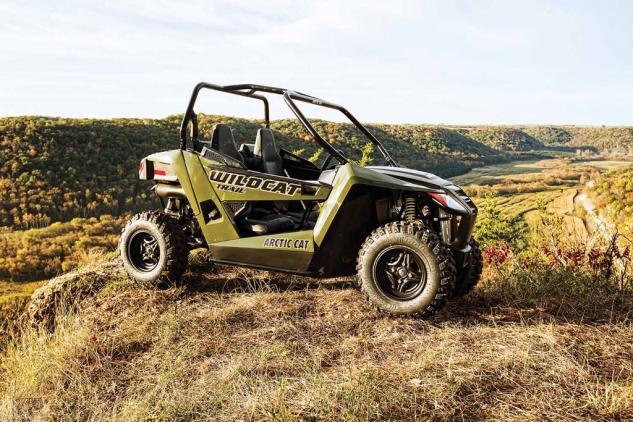
















![2012 Arctic Cat Wildcat 1000i Review [Video]](https://cdn-fastly.atv.com/media/2022/10/24/8762091/2012-arctic-cat-wildcat-1000i-review-video.jpg?size=350x220)

